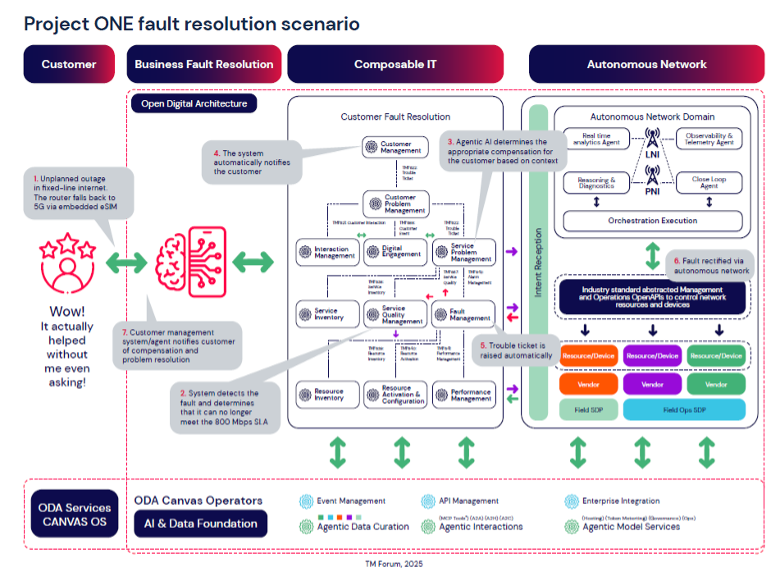TM Forum members are launching a new Innovation Hub pioneer project called Project ONE to make the Open Digital Architecture (ODA) AI-native. This requires building AI and data foundations and extensions to the ODA Canvas so that AI agents can communicate with ODA components and each other.

Project ONE aims to deliver agentic ODA
“When you want to deploy agents, they need access to large language models; they need access to data as a product; they need access to agent security and guardrails,” explains TM Forum’s Andy Tiller, EVP, Member Products and Services. “Project ONE is building all of that in the Innovation Hub.”
TM Forum plans to showcase Project ONE at DTW-Ignite 2026 in a scenario demonstrating end-to-end fault resolution using AI agents. The graphic below shows an example where a communications service provider’s (CSP’s) small business customer experiences an outage on their broadband connection. Their router has an embedded eSIM that allows it to switch over to 5G, but the CSP’s backend systems detect that the customer’s service level agreement (SLA) still cannot be met. So, the agent initiates a trouble ticket for autonomous fault resolution and delivery of compensation based on the SLA.

The idea is to highlight where agents may be a good replacement for humans throughout the journey from customer interaction to fixing the network fault. “We need to look for the parts of the picture where agents can do a better job than humans,” says Tiller, noting that it can be expensive to deploy AI agents, so their use needs to be reserved for instances where they can add value.
For example, humans have created extensive rules-based systems to determine appropriate compensation for customers, but “humans can never anticipate every situation”, Tiller explains. “Maybe this customer is about to renew their mobile subscription and offering them a better handset [instead of a bill credit] would be a win for everybody. For these kinds of things, I think you can argue agents are better than humans.”
Agentic AI goes beyond static workflows or rules-based automation. It reasons through situations, analyzes data, understands context and proposes solutions it can act on. For example, when a customer reports an outage and requests compensation, instead of simply quoting a policy, an AI agent can engage in negotiation.
“It might even say, ‘I think you’re asking for a bit much there. How about this instead?’” Tiller explains. Once the agent has negotiated the appropriate compensation with the customer, it can apply it by instructing the billing system to issue a refund.
“But it has obviously got to do that within guardrails,” Tiller adds. “So, you might give your AI agents guardrails saying they can compensate customers up to a value of $50 but after that you need a human to approve.”
A major goal of Project ONE is to showcase TM Forum’s three missions – Composable IT and Ecosystems, Autonomous Networks, and AI and Data Innovation – working together in the Innovation Hub, says Dr. Lester Thomas, Head of New Technologies and Innovation at Vodafone Group. “The missions are a really good articulation of what we’re setting out to achieve in Vodafone,” he says. “But the risk is that you end up with three architectures.”
The remedy is to make the ODA Canvas fully AI-native and add foundational layers like data products and access to AI services below the Canvas, Thomas says. The key is that everything is consumed through the Canvas, creating a unified architecture. This means that all the collaboration happening around autonomous networks, customer management and AI adoption aligns: “It’s all one open, digital architecture,” he explains.
Project ONE is bringing in new partners to help define and standardize data products, so that any software can request, say, a “fraud data product” in a consistent way. Different CSPs may have different datasets, but they should be discoverable through a shared standards-based catalog, Thomas explains.
An important goal of the project is to put the focus on customer experience rather than just technology. Because while a CSP’s network operations team might be narrowly focused on fixing a network issue, the effect of a fault or outage flows all the way to the end user.
The problem with having an isolated view is that “I don’t know who the customer is”, Thomas explains. “If I have ten problems, how do I know which one to address first? The network will have its view of what’s most important, but there might be a critical customer who should come first,” he adds.
It's important to note that the Project ONE team is not setting out to define a standard set of AI agents. Rather, it is focusing on how to build agentic applications on top of ODA.
“We’ve got no idea what agents are going to do. They could do a low-level task, or they could manage a whole complex process. They could appear and disappear ephemerally,” Tiller explains. “So, we’re not concerned about trying to create a standard set of agents. But what we do care about is how you manage and operate them.”
Tiller points to the way ODA components work as an example. Capabilities like identity and access management are not embedded into every individual component, each with its own user list and permissions. Instead, roles are defined centrally, and components then recognize those roles and apply the appropriate privileges.
Project ONE is using this approach with AI agents, making common capabilities, especially around data access and interaction with large language models, foundational and reusable, rather than duplicating them in every agent.
In the fault management scenario, when the AI agent decides to give the customer compensation, it must communicate with a billing component to accomplish this. It needs to do that through the only language the billing system understands which is the API, says Tiller.
The Project ONE team plans to use Model Context Protocol (MCP) and Agent-to-Agent Protocol (A2A) in their demo to enable an end-to-end experience for the customer. MCP provides the necessary translation between what the billing system’s API understands and the natural language that the AI agent understands, while A2A allows the agents themselves to communicate with each other.
“One of the key arguments about why it makes sense to build agentic applications on top of ODA is that once somebody has written a tool for the API, everyone can use it. If everybody’s got different APIs, you need to write the tool thousands of times,” Tiller explains. “ODA gives you a foundation on which you can build agentic AI-driven use cases, because you’ve got standards.”
He adds: “There’s a common misperception that MCP replaces APIs when you’re talking to existing systems, but APIs is their language… MCP is enabled by APIs.”
MCP and A2A have both been demonstrated in multiple TM Forum Catalyst proofs of concept. An ongoing, award-winning project called Agent Fabric, which is championed by a dozen CSPs including Vodafone, will feed into Project ONE in the Innovation Hub, according to Thomas.
“The role of the Innovation Hub is to take innovation ideas from Catalysts and make them more permanent accelerators, so that they don't become a once a year thing we showcase and then it disappears,” Thomas explains, noting that the ODA Canvas was born out of the Business Operating System Catalyst. “We’re hoping to do that for the Agent Fabric Catalyst.”